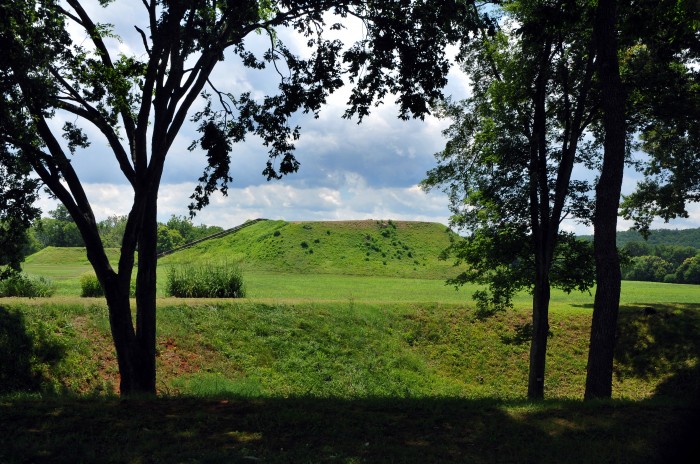A Brief Cherokee History
The Native group known as the Cherokee have existed for hundreds, maybe thousands of years.

There is much disagreement about their point of origin. Some say they migrated from the North. Anthropologist Dr. Timothy Jones says they were in the Midwest 1500 years ago. A chief of one of the island nations of the Pacific says she can prove that all Native Peoples of North America were originally Polynesian. One thing is certain: they are an enduring people.
Not much is known of their history until they encountered the Spaniards in the 1500’s. Over the ensuing years, European contacts increased. Since the Cherokee and the visitors from across the Atlantic came from two very different cultures, friction was inevitable.
At first, one foreign nation or another would court the Cherokee for their support. However, with the conclusion of the American Revolutionary War, the residents of the new United States of America had the country, more or less, firmly within their grasp. They no longer felt the need to curry the Cherokee’s favor. In fact, they increasingly regarded all Native Peoples as simply “being in the way”.
From then on, the treaties between the U.S. and the Cherokee became more and more unfair and restrictive. Larger and larger portions of land had to be ceded to the U.S., often millions of acres at once, to keep the “white man” temporarily sated.
Finally, two events, both in 1828, sealed the Cherokee fate: 1) Gold was discovered on Cherokee land in Georgia and 2) Andrew Jackson, a lawyer and land speculator with a broken moral compass, became president of the United States. The pressure to remove the Cherokee and others became too great and, in 1830, the Indian Removal Act was passed by Congress. The Supreme Court struck the Act down, declaring it to be unconstitutional. Andrew Jackson ignored the Court decision and went ahead with plans to move all of the so-called “Five Civilized Tribes” from the Southeast portion of the U.S., the Cherokee being one of them.
The Choctaw were first. Their treaty stipulations called for good food, plenty of doctors, and adequate transportation to an area in, what is now, Oklahoma. This proved to be expensive and no other tribe was afforded the fulfillment of that part of their treaty.
 The Cherokee were the last tribe to be moved, primarily because they resisted until the very end. Numerous letters were written, court cases presented, visits to Washington were undertaken. None were successful. Finally, in June of 1838, the first group of Cherokee left by river for their new “home”. This began a trek west that became known to the Cherokee as “the trail where we cried”. To most people, it is “the trail of tears”.
The Cherokee were the last tribe to be moved, primarily because they resisted until the very end. Numerous letters were written, court cases presented, visits to Washington were undertaken. None were successful. Finally, in June of 1838, the first group of Cherokee left by river for their new “home”. This began a trek west that became known to the Cherokee as “the trail where we cried”. To most people, it is “the trail of tears”.
Many of the people from the first group did not survive. Right after they left, a terrible drought struck the Southeast and it was deemed inadvisable to send the remaining two groups out. They were, instead, locked in a compound for the duration of the drought. Between thirteen thousand and fifteen thousand Cherokee were crammed together in inadequate space with insufficient supplies of food, water and hygienic facilities for two months. Many died.
In August, the dry conditions broke and the last two groups started out overland. Neither they nor the group before had sufficient food, water or clothing for the journey confronting them. With treaty stipulations no longer a consideration, every corner was cut to save money. The food was spoiled, the water contaminated, they had to provide their own transportation, the only clothing or blankets they had were what they brought with them. The words of a traveler in Kentucky, one of the land routes to the destination, tells part of the sad story:
 “We found the road literally filled with the procession for about three miles in length. The sick and feeble were carried in waggons . . . a great many ride horseback and multitudes go on foot—even aged females, apparently nearly ready to drop into the grave, were traveling with heavy burdens attached to the back—on the sometimes frozen ground, and sometimes muddy streets, with no covering for the feet except what nature had given them.”
“We found the road literally filled with the procession for about three miles in length. The sick and feeble were carried in waggons . . . a great many ride horseback and multitudes go on foot—even aged females, apparently nearly ready to drop into the grave, were traveling with heavy burdens attached to the back—on the sometimes frozen ground, and sometimes muddy streets, with no covering for the feet except what nature had given them.”
In March, 1839, after a journey of perhaps one thousand miles, the final Cherokee arrived at their new location. A total of four thousand had lost their lives on the way. The wife of the Cherokee chief, John Ross, was among the casualties.
The aptly named “Trail of Tears” was a truly black spot on the history of the United States. Sadly, with respect to the Cherokee and all their brother and sister “First Peoples”, it is not the only one. The United Cherokee Nation of Indians is working very hard to ensure it is the last.
“The people were herded into wooden stockades, into staging areas around the Cherokee Nation, in what were literally cattle pens.”
— Gayle Ross (Cherokee)


